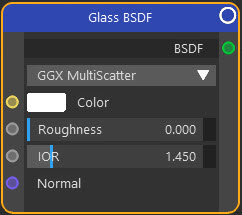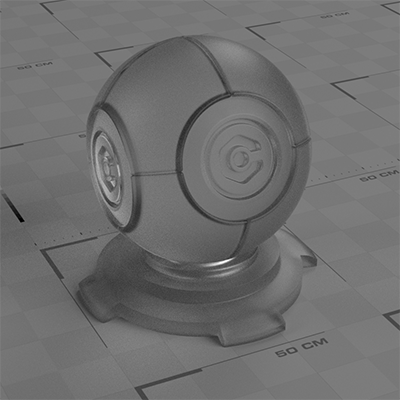Shaders: Glass BSDF
Node Interface

Example Output
Overview
| Function | A glass material with refraction and reflection |
| Nearest C4D equivalent | Simple material with the transparency channel enabled |
This node is used for materials which must refract light passing through them and at certain angles also reflect light. For purely transparent materials, see the Transparency BSDF node; for reflections without refraction, see the Glossy BSDF node; for a refractive material that does not reflect, see the Refraction BSDF node.
This material will generate caustics if they are turned on in the render settings.
 Important - by default, the Max Ray Bounces in the render settings are set to 1 for the fastest preview. In the Glass BSDF node this will result in no internal reflections so for better results, if you use this node you should increase the Max Ray Bounces value to 2 or more.
Important - by default, the Max Ray Bounces in the render settings are set to 1 for the fastest preview. In the Glass BSDF node this will result in no internal reflections so for better results, if you use this node you should increase the Max Ray Bounces value to 2 or more.
Settings
Note: a * symbol next to the name indicates the parameter also has an input port. A # symbol indicates that the parameter can only be changed with an input node, not in the node itself.
Distribution drop-down
This menu lets you choose the distribution algorithm for how refraction is calculated. If the Sharp algorithm is selected, the Roughness setting has no effect.
The default setting is GGX Multiscatter which solves a problem with GGX mode in that as the Roughness value increases, the surface become darker. However, it does produce a slightly noisier result.
Color *
You can change the colour directly in this parameter, but you can input the colour from any other node which has a Color output. This is where you would link an Image Texture node to use a bitmap, for example.
In this node, the brightness of the colour will affect the transparency and the colour of reflections (which is not physically accurate). Pure white is 100% transparent; pure black is completely opaque.
Roughness *
The roughness of the refraction; useful for such things as frosted glass. Note that increasing this value may increase the risk of render artefacts such as fireflies. It has no effect if the distribution is set to Sharp.
With distribution set to Beckmann and a roughness of 0.2, this is the result:
IOR *
The index of refraction. Different materials have different IORs and this will affect the rendered result. The default value of 1.45 is the IOR of plain glass.
Normal #
With this setting you can alter the surface normals of the object, which will have a significant effect on the rendered output since it will affect the way light is reflected from the surface.
This setting requires a vector input, so you need to link another node with a vector output port to this port.
Output
BSDF
A shader port which can be linked with shader ports on other nodes.

